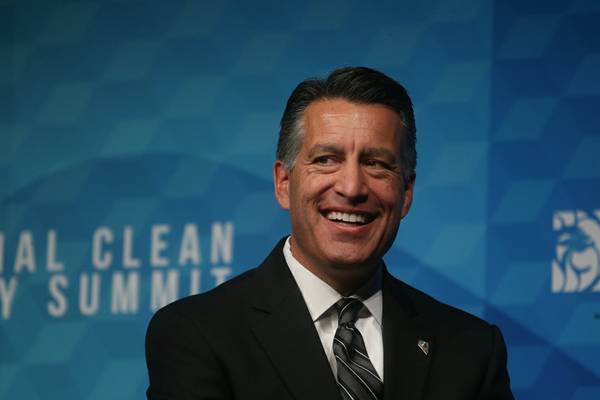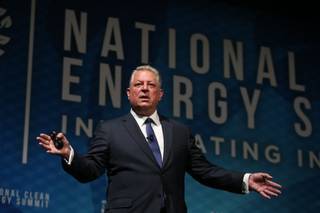Related Coverage
Batteries could play a major role in renewable energy in the future, according to a governors panel moderated by Gov. Brian Sandoval that closed out the National Clean Energy Summit on Friday.
The summit brought hundreds of environmentalists and members of the renewable energy industry to the Bellagio to hear how green technology can be integrated with transportation, buildings and electric grids. Massachusetts Gov. Charlie Baker, a Republican, and Hawaii Gov. David Ige, a Democrat, spoke with Sandoval about what their states are doing to reduce their impact on the environment.
Both said batteries that store unused energy generated from solar panels can still be improved and could give more residents access to solar power. Tesla, which is building its battery factory in Northern Nevada, has been part of a project in Hawaii to couple solar panel systems with energy storage.
“To me, we’re the cradle of battery storage,” Sandoval told reporters after the summit. “They’re making them right here, so absolutely I think that’s a big part of this. You see all the solar generation that we have here, and when you put that together with the storage, that’s going to be fabulous for Las Vegas.”
Sandoval signed legislation this year giving the Public Utilities Commission of Nevada until October of next year to determine whether battery systems would improve the electric grid and reduce greenhouse gas emissions.
The Hawaii Public Utilities Commission has approved traditional rooftop solar systems and systems equipped with battery storage systems for customers.
“The economics of solar, plus battery, is really driving down the cost of clean renewable energy because we charge the batteries during the day and then deliver the energy at night when the peak demand occurs,” Ige said. “I do see that that’s going to be economically viable sooner rather than later.”
Baker launched an initiative in his state to work with some of the research organizations in Massachusetts and put about $10 million into finding ways to encourage energy storage development, he said.
“Part of that’s because of the intermittent nature of wind and solar in the first place, but … it’s also because the storage technology is getting to the point where you could start to see it becoming a standard component of rooftop solar in residential settings,” Baker said.
Ige said Hawaii also has community solar programs to benefit those whose residences do not give them access to a rooftop where they can install solar panels. Sandoval actually vetoed a similar measure after this legislative session. He said after the event that he had no regrets over that veto and that his concerns still stand.
“I liked the bill, the whole issue was the timing of energy choice,” Sandoval said, referring to the state’s Energy Choice Initiative, which comes up for a second vote next year and seeks to open the electricity market to competition. “When you juxtapose the two of those next to one another, there are some unanswered questions, and I think we need to wait until the voters make that decision in the next election.
He said it’s very likely that the initiative will pass “overwhelmingly,” and that’s why he appointed a committee to research the policy implications of implementing the measure. Sandoval said he himself voted for Question 3 the first time around, and he plans to do so again next year.
“Now the next session of the Legislature will be informed,” he said. “They will know whether the choice question has passed, which it likely will, and then they’ll have an entire session and have the benefit of all that research.”
Sandoval’s term ends in January 2019 before the next legislative session starts. Until then, the term-limited governor said finishing the electric charging stations on the Nevada Electric Highway, along U.S. 95 from Las Vegas to Reno, is one of his renewable energy goals. He said he’d also like to see charging stations on U.S. Route 50, known as the loneliest road in America.
Sandoval said the charging stations from Las Vegas to Reno could be completed by early next year.
“We’ve got to get the funding for that,” Sandoval said. “I can’t wait to get in an (electric vehicle) and drive that.”


